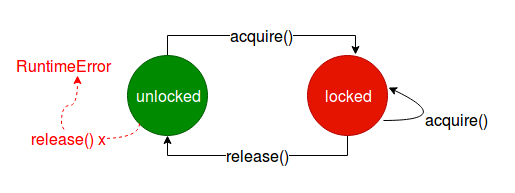Python 多线程编程(二):threading 模块中 Lock 类的用法详解
大概可以这样讲,多线程最难的是如何正确协调各个线程修改同一份数据。
以卖票的例子作为说明。
买票有多个窗口,假设有 3 个好了,窗口之间共享一个票池,每个窗口都可以买票直到票池里面没有票可以卖。
不难写出下面的代码。
import threading import random class WindowThread(threading.Thread): def __init__(self,name): threading.Thread.__init__(self,name=name) self.name = name self.tickts = 0 def run(self): global tickt_count while tickt_count > 0: print('%s notice:There has %d tickts remain ' %(self.name,tickt_count)) if tickt_count > 2: number = random.randint(1,2) else: number = 1 tickt_count -= number self.tickts += number print('%s have buy %d tickt,the remain tickt\'t count is %d .Already buy %d \n' % (self.name, number, tickt_count, self.tickts)) print('%s notice:There is no tickt can sold! Already sold %d'%(self.name,self.tickts)) tickt_count = 10 window1 = WindowThread('window1') window2 = WindowThread('window2') window3 = WindowThread('window3') window1.start() window2.start() window3.start() window1.join() window2.join() window3.join() print('tickt count ',tickt_count)
假设有 3 个窗口,总共有 10 张票。
在每个窗口排队购票时,窗口会告诉你当前还剩多少票。
if tickt_count > 2: number = random.randint(1,2) else: number = 1 tickt_count -= number self.tickts += number
每个人最多购买 2 张票,如果票池当中只剩下 1 张票时,那么也只能购买一张票了。
tickt_count 是票池里面剩余的票的数量。
tickts 是每个窗口已经卖出的数量。
购买结束后,要更新票池里面剩余票的数量,和更新本窗口卖出去的票数。
最后,所有的窗口无票可卖的时候,结束。然后打印 票池里面的票数,理论上应该是 0,因为票已经卖光了。
我们看结果运行如何:
window1 notice:There has 10 tickts remain window2 notice:There has 10 tickts remain window1 have buy 2 tickt,the remain tickt't count is 8 .Already buy 2 window2 have buy 1 tickt,the remain tickt't count is 7 .Already buy 1 window1 notice:There has 7 tickts remain window1 have buy 2 tickt,the remain tickt't count is 5 .Already buy 4 window1 notice:There has 5 tickts remain window1 have buy 1 tickt,the remain tickt't count is 4 .Already buy 5 window1 notice:There has 4 tickts remain window1 have buy 1 tickt,the remain tickt't count is 3 .Already buy 6 window1 notice:There has 3 tickts remain window1 have buy 2 tickt,the remain tickt't count is 1 .Already buy 8 window3 notice:There has 1 tickts remain window1 notice:There has 1 tickts remain window1 have buy 1 tickt,the remain tickt't count is 0 .Already buy 9 window1 notice:There is no tickt can sold! Already sold 9 window3 have buy 1 tickt,the remain tickt't count is -1 .Already buy 1 window3 notice:There is no tickt can sold! Already sold 1 window2 notice:There is no tickt can sold! Already sold 1 tickt count -1
多运行几次,可以发现一个现象,那就是结果不正确。
3 个窗口的卖出的总数对不上。
最后显示 tickt count 为 -1,而不是 0,这显然不符合我们的预期。
Q:为什么会这样呢?
A:因为我们没有保护好多个线程之间,共享的数据。
Q:怎么能解决呢?
A:Lock 机制可以解决
什么是 Lock?
Lock 中文称为锁,是一种初级的多线程同步的手段。
Lock 有 locked 和 unlocked 两种状态,而这两中状态之间是可以转换的.
- 当 Lock 是 unlocked 状态时候,某个线程调用 acquire() 可以获取这个 Lock,并且将 Lock将状态转换成 locked 状态,并且线程不会阻塞。
- 但当 Lock 是 locked 状态时,某个线程调用 acquire() 会阻塞自己,直到其他的线程将 Lock 的状态变成 unlocked。
- 当 Lock 是 locked 状态时,调用 release() 方法,可以释放一个 Lock,这样其它线程就可以获取这个 Lock 了。
- 但当 Lock 是 unlocked 状态时,某个线程调用 release(),程序会抛出 RuntimeError 异常。
所以,acquire() 和 release() 方法在单个线程当中都是成对使用的。

有效利用 Lock 的状态转换机制,就可以避免多个线程同时修改同一份数据。
于是,我们可以进行代码的改写。
import threading import random class WindowThread(threading.Thread): def __init__(self,name,lock): threading.Thread.__init__(self,name=name) self.name = name self.tickts = 0 self.lock = lock def run(self): global tickt_count while tickt_count > 0: print('%s notice:There has %d tickts remain ' %(self.name,tickt_count)) self.lock.acquire() if tickt_count > 0: if tickt_count > 2: number = random.randint(1,2) else: number = 1 tickt_count -= number self.tickts += number print('%s have buy %d tickt,the remain tickt\'t count is %d .Already buy %d \n' % (self.name, number, tickt_count, self.tickts)) self.lock.release() print('%s notice:There is no tickt can sold! Already sold %d'%(self.name,self.tickts)) tickt_count = 10 lock = threading.Lock() window1 = WindowThread('window1',lock) window2 = WindowThread('window2',lock) window3 = WindowThread('window3',lock) window1.start() window2.start() window3.start() window1.join() window2.join() window3.join() print('tickt count ',tickt_count)
还是 3 个线程,但代码少许不一样。
lock = threading.Lock() window1 = WindowThread('window1',lock) window2 = WindowThread('window2',lock) window3 = WindowThread('window3',lock)
3 个线程共用 1 个 Lock 对象。
self.lock.acquire() if tickt_count > 0: if tickt_count > 2: number = random.randint(1,2) else: number = 1 tickt_count -= number self.tickts += number print('%s have buy %d tickt,the remain tickt\'t count is %d .Already buy %d \n' % (self.name, number, tickt_count, self.tickts)) self.lock.release()
进行关键数据操作的时候,用 Lock 锁起来,这样每次就只能一个线程对 tickt_count 数量进行修改。
最终程序结果运行如下:
window1 notice:There has 10 tickts remain window1 have buy 1 tickt,the remain tickt't count is 9 .Already buy 1 window2 notice:There has 9 tickts remain window1 notice:There has 9 tickts remain window2 have buy 1 tickt,the remain tickt't count is 8 .Already buy 1 window3 notice:There has 8 tickts remain window2 notice:There has 8 tickts remain window2 have buy 2 tickt,the remain tickt't count is 6 .Already buy 3 window2 notice:There has 6 tickts remain window3 have buy 2 tickt,the remain tickt't count is 4 .Already buy 2 window3 notice:There has 4 tickts remain window2 have buy 2 tickt,the remain tickt't count is 2 .Already buy 5 window2 notice:There has 2 tickts remain window1 have buy 1 tickt,the remain tickt't count is 1 .Already buy 2 window1 notice:There has 1 tickts remain window3 have buy 1 tickt,the remain tickt't count is 0 .Already buy 3 window3 notice:There is no tickt can sold! Already sold 3 window2 notice:There is no tickt can sold! Already sold 5 window1 notice:There is no tickt can sold! Already sold 2 tickt count 0
可以多试几次,窗口卖出的票数都是可以对的上号的,并且最终票池里面的数量是 0,不会发生之前出现为 -1 的情况。
所以,自此我们就通过引入 Lock 同步机制,进行了一个很简单化的多线程编码示例。
默认情况,当一个 Lock 是 locked 状态时调用 acquire(),会阻塞线程本身。
但我们可以设置不阻塞,或者是阻塞指定时间。
#不阻塞 lock.acquire(False)
#阻塞指定时间,如 3 秒钟,当然 python3 的版本才有这个功能lock.acquire(timeout=3)



